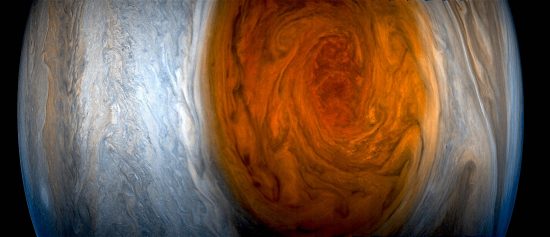
Jupiter’s Great Red Spot from the Juno spacecraft and citizen scientists. Original image credit: NASA-JPL/SwRI/MSSS/Gerald Eichstädt/Seán Doran
Nov 15, 2018
Jupiter’s Red Spot is shrinking.
For over 300 years, the Great Red Spot has persisted in Jupiter’s atmosphere—longer than telescopes have existed to see it. It is commonly believed to be a cyclonic storm driven by thermal convection from deep inside Jupiter’s atmosphere. How it was formed and why it has lasted so long remain a mystery.
No one is sure why it is red in color. For that matter, scientists are not sure why any of the gas giant planets possess unique color schemes. Neptune has a blue tint, Uranus green, Saturn is pale yellow, and Jupiter is a rusty red, overall.
According to a recent press release, when Voyager 2 flew by Jupiter almost 50 years ago, the Great Red Spot was as large as three Earth diameters. Now, it’s only about one Earth wide. Glenn Orton, a planetary scientist at NASA’s Jet Propulsion Laboratory said:
“If you look at pictures from the late 19th century, you’d swear it was the great red sausage.”
Conventional theories suggest that warmer areas in the center of the Spot are enough to cause its rotation, also turning the center a darker red. The red color’s origin—whether from chemical changes in the atmosphere or upwelling of other materials from below—requires further study. Some investigators think that “vertical flow” from warmer regions below maintain the Great Red Spot. Identifying it as a storm means that those vertical flows circulate hot and cold gas in and out of it, thus preventing it from dissipating.
From an Electric Universe perspective, the Great Red Spot could have a different origin altogether: Jupiter’s turbulent atmosphere might be receiving its energy from an external source.
A previous Picture of the Day described gigantic “plasma tornadoes”, or flux tubes, entering Earth’s magnetosphere from space. They were found by the fleet of THEMIS satellites when they flew through the highly charged structures. The tubes are spinning at more than 1.5 million kilometers per hour and generating over 100,000 amps of electric charge flow.
As mentioned in many past articles, twisted electromagnetic filaments are the characteristic signature of Birkeland currents. Electric fields generate magnetic fields. The fields interact with magnetic fields generated by other flows of charge, forming twisted electromagnetic strands named after the one who originally discovered them, Kristian Birkeland. Birkeland currents “pull” with a force that can be orders of magnitude greater than gravity. Electric Universe advocate Donald Scott found that they can attract each other with a force that falls off with the square root of the distance, as opposed to gravity’s square of the distance.
Birkeland currents rotate around each other, beginning as many strands spinning around a common center in pairs. At first, there might be 56 filaments that merge into 28, then 14, and so on. As more current flows through the circuit, there are fewer filaments, but each pair becomes more energetic. Where Birkeland currents intersect, z-pinch compression zones occur, glowing brightly as the plasma density increases, releasing abundant radiation.
Perhaps it is the influx of plasma filaments into Jupiter’s electrically charged environment that creates the Great Red Spot. In an image of Jupiter, several bright points can be seen surrounding the Spot in an arc-shaped array. Below it is another bright arc-shape, indicative of increased infrared radiation emissions.
Rather than vertical flow and convection from below, the Spot is probably rotating because external electromagnetic fields are influencing the atmosphere. The Great Red Spot, as well as other rotating vortices on Jupiter, could be where variable Birkeland currents impinge on the giant gas planet. Those variations would cause changes in the size and activity of the vortices on Jupiter.
Stephen Smith












